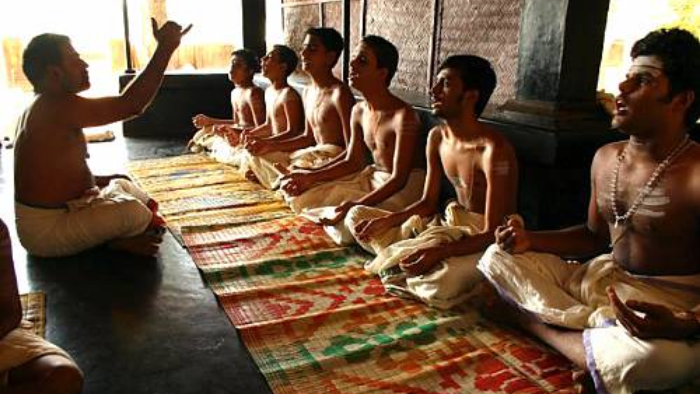Regarded by Indians as the primary source of knowledge, the Vedas are the oldest surviving cultural traditions. Vedic chants have been heard in India for more than three thousand years, and is considered the oldest continuous vocal tradition. This was precisely why UNESCO recognised it and added it to UNESCO’s list of Intangible Cultural Heritage (ICH)
The four Vedas- Rig, Yajur, Sama and Atharva, consist of more than a thousand hymns that are chanted on various occasions in India. Veda Parayan forms an important part of many religious festivals. Veda Patashaalas (schools) across the country have students from all ages learning the Vedas. This forms a significant part of the Guru-Shishya Parampara in India.
The students live with their gurus throughout the period of their education, learning under them, while also serving their gurus. The mode of education has always been via oral means. Today most schools have printed books, but the means of teaching continues to be oral. At the end of their Vedic studies, they are tested by their gurus and many others on different aspects of the Vedas.
It is interesting to see how the prominence of the Vedas have travelled far and wide, attracting thousands to India. Many seekers who travel to India settle down and practice Vedic chanting. Besides that, there are Vedic studies forums in many parts of the world that impart Vedic chanting to those who are keen on learning.
CSP was fortunate to speak to many such students from different parts of Europe. All of them have been under the tutelage of Shantala Sriramaiah, founder and instructor, Veda Studies. An engineer by profession for more than twenty years, she now invests her time in studying with several teachers, guiding her practice, and also teaches several non-Indian students, in Belgium.
For many of her students, Vedic chanting has benefitted them in many ways. For Sarah van Lamsweerde, chanting has played quite a role in her art. She says, “The daily practice of chanting has helped me focus and channel my feelings that are now more in sync with my work.”
When Ramatara first landed in India, her experience was nothing short of overwhelming. She attended various discourses which were mostly in Sanskrit and Hindi, which she initially did not understand. Today, she says that those very Sanskrit words deeply resonate with her. “When I chant my mind completely dive into the repetition, it is like chewing a candy, the more you practice the more you want it again and again until you are so filled with the taste that you can rest in silence and peace,” she said.
Eight years ago, Dorien, a music therapist for children and adults with disabilities, chanced upon Vedic mantras. For her, chanting is very personal, and this is something she has not come across in her years of education. She loves the sound of Gayatri Mantra and has become very special to her.
Experiences from many such people are heart-warming to hear. Vedic chanting has a very powerful effect on our mind. When students learn the Vedas, they become highly proficient in Sanskrit, since the Vedas are written in Sanskrit. Being proficient in Sanskrit has many benefits which includes improved speech and better brain development.
In collaboration with India-Trento Partnership for Advanced Research and the National Brain Research Institute, New Delhi, Prof James Hartzell conducted research a couple of years ago on the effect of chanting the Vedas on brain development, and his results were definitely fascinating. The study was conducted between trained scholars and untrained people of similar age and gender.
He used structural magnetic resonance imaging (MRI) to scan the brains of the scholars and the untrained people (control). What he saw was remarkable. There were regions of the brains of the scholars that were larger than the control. More than 10% grey matter was found across both cerebral hemispheres. Along with this finding, he also noticed that the right hippocampus that is responsible for verbal memory also had more grey matter than the control.
The right and left hippocampus in all of us is highly essential to record new information. The right is specialised for patterns related to sound, spatial and visual. The increase in grey matter over this region in the brains of the scholars was thus accurate, and this can be attributed to the power of chanting. The right temporal cortex in the brain is responsible for speech prosody and voice identity. This area in the scholars’ brain showed substantial thickening.
Further research has to be conducted to understand if these findings such as increase in grey matter and thickening of the cortical region, makes people less prone to brain degeneration diseases such as Alzheimer’s.
When one enters a temple or attends Veda parayan, the sounds reverberating across the space leaves one wonderstruck. Each pandit chants more than a thousand slokas for hours, without a single error, each stanza of a particular tone and pitch. The above findings open our eyes to the multifold benefits of chanting. It is not a surprise that it is part of UNESCO’s list of Intangible Cultural Heritage (ICH).




